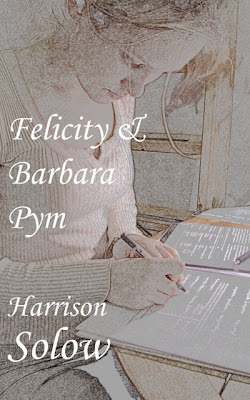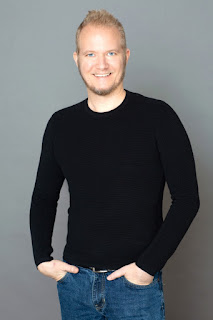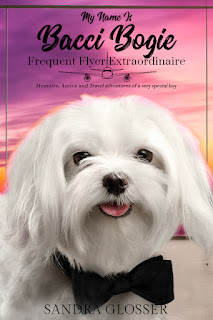10 Questions with Writer Dr. Harrison Solow (@HarrisonSolow)

This Author Spotlight
features Los Angeles-based writer
Dr. Harrison Solow
winner of the Puschart Prize
and
author of
Felicity & Barbara Pym
1. How did you get into writing?
By reading. My mother read to me all the time – and taught me to read when I was about 3. By the time I was seven, I had already read hundreds of books. I read a hundred books between June and September just before third grade as part of a library contest for children. You had to take a brief quiz administered by the librarian on each book to prove that you had read it. I still have the certificate. Of course these were simple children’s books, but I mention this to indicate the intense relationship with literature and the word that began at a very early age.
I never planned to be a writer – I was more interested in illustrating books than writing them when I was a child and much more interested in teaching than either. Writing just naturally evolved from my life with books and from the writing (essays and stories) assigned in school and university, and in the convent.
What I like best and least about writing depends on the kind of writing I am undertaking. In addition to my own books, I write for a number of clients - movie studios, non-profit agencies, corporations, government institutions, lawyers, celebrities, rabbis, publishers, cultural organizations, etc.
When I am writing for others, what I like best is the bridging of worlds. I am usually contracted to make obscure texts, agendae or missions clear to an audience that would not otherwise easily understand them. One example is developmental writing for a scholarly publisher whose authors are eminent scholars but who really cannot write very well, particularly for a general audience. Sometimes I do the research, sometimes they supply the research that I write up for whatever publication is needed. Sometimes they provide an original manuscript and I rewrite it for clarity and interest.
I’ve rewritten books on art, on physics, on education, on the entertainment industry, on science fiction – and much more. I was once contracted to re-write Genesis in a particular edition of the Bible that was written by erudite theologians who spoke five languages, but did not write well in English.
To be able to bridge the world of the scholar/researcher (or even another writer whose subject or material is obscure) and the world of the intelligent reader who wants to enter that world is a great satisfaction.
There isn’t really anything I don’t like about that. It is fascinating work – it requires and fulfills the particular set of skills I seem to have, it contributes to the disbursement of knowledge and it pays very well.
Regarding my own original work, what I like best is connecting my disparate experience and knowledge into a cohesive narrative – joining ideas that may not have been joined before (to my knowledge) and comparing the essence of one experience I’ve had or one world of which I’ve been a part, with another. And above all, joining fiction with non-fiction. For example, in my last published book, Felicity & Barbara Pym, I wove my experience in Hollywood, the convent and academia into a story that celebrates (and investigates the purpose of) literature. It is both fiction and nonfiction. I love doing that.
What I like least about writing books and stories in the initial stage is the distraction that inevitably necessitates a battle with other (and at times equal) claims on my time, something that does not seem to happen in my professional writing.
Again, the process differs with purpose. In my professional writing, I work to a schedule and budget I devise for each project based on the deadlines I’ve been given, and generally keep a traditional working day – starting between 6 and 7 am and wrapping up around 3 or 4. Sometimes, I return to that work in the evening, but usually not.
Writing stories and books is different. I write whenever I get up until I lose interest or energy – which at first can be as little as 15 minutes to an hour. Once I enter the world I am creating, however, a journey which can take days, weeks or months, I write intensively, continually, obsessively at times, and find it difficult to break for any purpose.
There are so many writers I admire for different reasons - ideas, intelligence, storytelling abilities, philosophies, clarity, mysticism, knowledge, imagination, verbal acuity, humour, finesse, poetics, etc – in varied combinations – I don’t know where to begin, but a short list is below. Some are or were friends. Some, most, are strangers except through their words. Although it really isn’t possible to entirely separate each of these myriad qualities of writing from the others, among those I read and admire for different combinations of these qualities (in no particular order) are Anita Brookner, Coleridge, AS Byatt, Isaac Asimov, Mortimer Adler, Thomas Aquinas, Arthur C. Clarke, Harlan Ellison, Herman Wouk, Antonia White, Tobias Wolff, Somerset Maugham, Paul Davies, Alan Lightman, Virginia Woolf, Adam Gopnik, Margaret Drabble, Willa Cather, Loula Grace Erdman, Elizabeth Eslami, John Henry Cardinal Newman, Aristotle, Chaim Potok, John Donne, Fay Weldon, Dorian Llywelyn, Geoffrey Chaucer, Thaisa Frank, William F. Buckley, Jan Morris, Gerard Manly Hopkins, Iris Murdoch, Kierkegaard, Jane Austen, Hazel Holt, EM Forster, Rachel Billington, Elizabeth Ehrlich, all three Brontes and I’m going to stop here, because there are just too many to list.
Outside.
I’m not sure I have anything so definitive as a stance, but I use it. I find it sensible and helpful in maintaining clarity. Whether or not others use it is pretty much a matter of indifference to me, unless it is the policy of the university in which I am teaching (which it was) or the preference of a client. I’ve earned three degrees in English – each in a different country under different grammatical and stylistic rules: Canada, the USA, and the UK. I write using three different manuals of style: MLA, MHRA and The Chicago Manual of Style (and I’ve used others) so flexibility is the key here. :) Consistency is all that practically counts.
I just answered this question in a seminar last week. (Felicity & Barbara Pym was adopted as a course text in 20th Century Literature in the English Department at Mills College in California) so I’ll just quote the answer I gave to the students:
“In its inception, Felicity & Barbara Pym, was less a concrete idea than an act of academic imagination. In a slightly different format, this work constituted part of my rigourous Master of Fine Arts degree requirement at Mills College in California, one of the few remaining private Liberal Arts colleges for women in America. In order to qualify for the MFA in Literature & Writing (at that time, at least) one was required to both study literature and write a creative work. One’s thesis had to give evidence of accomplishment in both. I thought that writing a creative work about the study of literature would be a fascinating way to demonstrate such accomplishment.
In thinking about how to achieve this, I realized that I had inherited much of my literary philosophy from my own undergraduate tutor, who had been a student of FR Leavis at Cambridge and a literary exemplar to me two decades earlier. His great pedagogical/literary gift to me – the interrelatedness of all of literature, and the literary history and context I hold in my head, was something I wanted to pass on to my students with the conviction, passion, discipline with which I had been taught. So I decided to write a dialogue between a student just beginning literary studies and a seasoned professor of literature – but to include only the professor’s letters (which later I changed to email). It’s very easy to tell, from what the professor (Mallory) writes, the content of the student’s (Felicity’s) letters.
I chose to centre this thesis around the novels of Barbara Pym, because by then, I had become deeply engaged with her work. I knew it well and found that not many other academics did. As there was comparatively little written about her at that time, I was able to fulfill one of the principle tenets of scholarship: to make an original contribution to Literary Studies. If I were able to illuminate the worth of this relatively obscure author to a very young and not very interested college student standing on the cusp of the 21st Century, in a creative work, I felt I would have earned the title of Master, which was about to be conferred on me.
So I embarked on this unsailed sea and thus Felicity and Barbara Pym, an epistolary novel, or what was called by one Harvard editor, “a masterfully done epistolary novel cum memoir cum literary critique cum advice column” was born. What readers enjoy - and mention often is how much they enjoy the humour in it. It’s not a traditional literary study. It’s a story.
Felicity & Barbara Pym has enjoyed surprising success in the UK where it was published, and is beginning to have a following here in the USA so I think there will be an American edition of Felicity & Barbara Pym in the near future."
There is more information about the book on the Felicity & Barbara Pym website, including reviews, at: http://bit.ly/FPZok1 It is available at bookstores in the UK and on amazon.com
8. What’s your current writing project?
8. What’s your current writing project?
I have four projects underway in various stages of process. One is the American edition of Felicity & Barbara Pym (http://bit.ly/w6L8Xn) which was first published in the UK; one is a children’s book called Barnaby’s Chance (http://bit.ly/yriz4C), which is with a prominent children’s book editor; one is a book I am writing/creating/wresting from my PhD dissertation, The Bendithion Chronicles (based on the Pushcart Prize essay, Bendithion http://tinyurl.com/solow-bendithion); and one is a novel I’ve just begun.
9. What book(s) are you currently reading?
I do a lot of re-reading along with discovering new books – deep-reading in the tradition of lectio divina. Currently, the books I am re-reading are The Canterbury Tales, Anita Brookner’s novels in order of publication, The Poetics of Space and a selection of children’s books I always keep by the bedside. One of the books I am reading for the first time is, unsurprisingly, On Rereading by Patricia Meyer Spacks, and another is American Austen: The Forgotten Writing of Agnes Repplier edited by John Lukacs. There are also books I study, which is quite a different thing.
10. Who or what inspires your writing?
“I don’t know. I don’t look at it. Don’t pay attention to it. I can tell you what initiates it, though. Arrested experience. When suddenly, something just stops you in your tracks and you forget to breathe for a moment. That’s when I write about something. I portrayed such a moment in “The Postmaster’s Song”, which actually is a true story, though I called it fiction because it is just easier than arguing with people and it is written narratively, with some fictional components (though these components aren’t the things people think they are in the story). It is about the moment when I decided to write Bendithion. It can be found at: http://www.redroom.com/ blog/harrison-solow/the-postmasters-song
That arrested moment is “what” inspires the content of my writing. It of course inspires the desire to write, but the major impact of that moment is what to write about. I’m not a person who generates a prolific stream of ideas. I know and admire people like that – my husband is one – he has hundreds of ideas a day, but I need a great force, an unplanned source to inspire content. That force/source for me is usually centred in the liminal. In a short essay on Liminality, I concluded thus: “A writer must stand on thresholds that are not revealed until she has reached – or created – them, and enter worlds that he has never seen until he gets there. A writer must live liminally, in a chasm called ‘between’ because he can’t do what he has to do if he is looking at it. For me, at least, this has always been true. (http://redroom.com/member/harrison-solow/blog/liminality)
With regard to the second of those definitions above, the “who” would refer specifically to thinkers/writers like AS Byatt, Anita Brookner, Alan Lightman, Adam Gopnik, Dorian Llywelyn, Isaac Asimov, Thomas Aquinas, John Henry Cardinal Newman, Willa Cather, Virgina Woolf (to name a very few). Generally I have to say all the literature I have read throughout my life in some way or another contributes to my own work. My own passion for this literature inspires not only the desire to write but the manner in which it is written. Not consciously, but by proximity, intimacy, inflection.
As for the first definition – the act of writing, most writers have a few people in their lives whose company, correspondence, conversation stimulate thought, generate ideas, and enliven creativity in differing measures – friends, fellow writers, and at times, strangers. Foremost among these for me is a particular friend and colleague, a brilliant writer himself, who is a genuine catalyst for my own writing. Other sources of inspiration are (Welsh-speaking) Wales, New York (city) and believe it or not, hospitals, libraries, and monasteries.
There isn’t anything I’d like to add at this time, except to thank you, Ryan, for the invitation to be on Author’s Spotlight.
Read Harrison's Pushcart Prize-winning story "Bendithion" here: http://tinyurl.com/solow-bendithion.
Trust me; it's something you want to read.
Visit the book's website http://bit.ly/w6L8Xn and grab a copy of Harrison's novel Felicity & Barbara Pym or pick up a copy from Amazon at the link below:
Visit the book's website http://bit.ly/w6L8Xn and grab a copy of Harrison's novel Felicity & Barbara Pym or pick up a copy from Amazon at the link below:
Felicity & Barbara Pym



Comments
Post a Comment